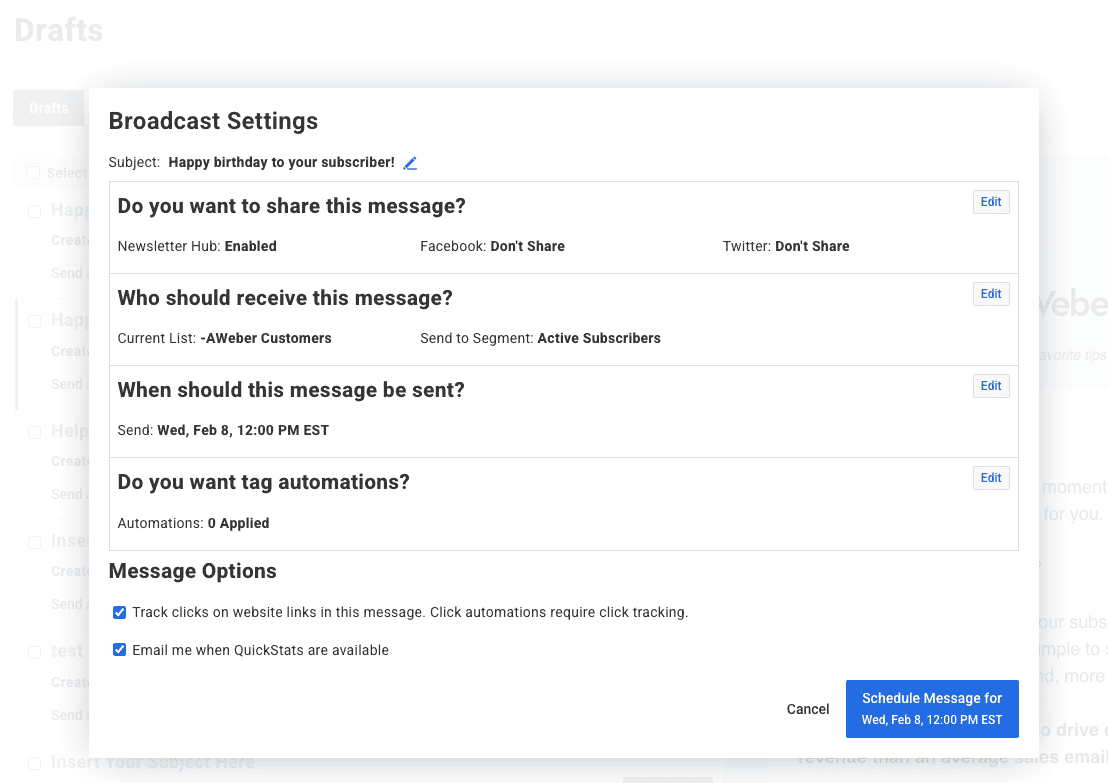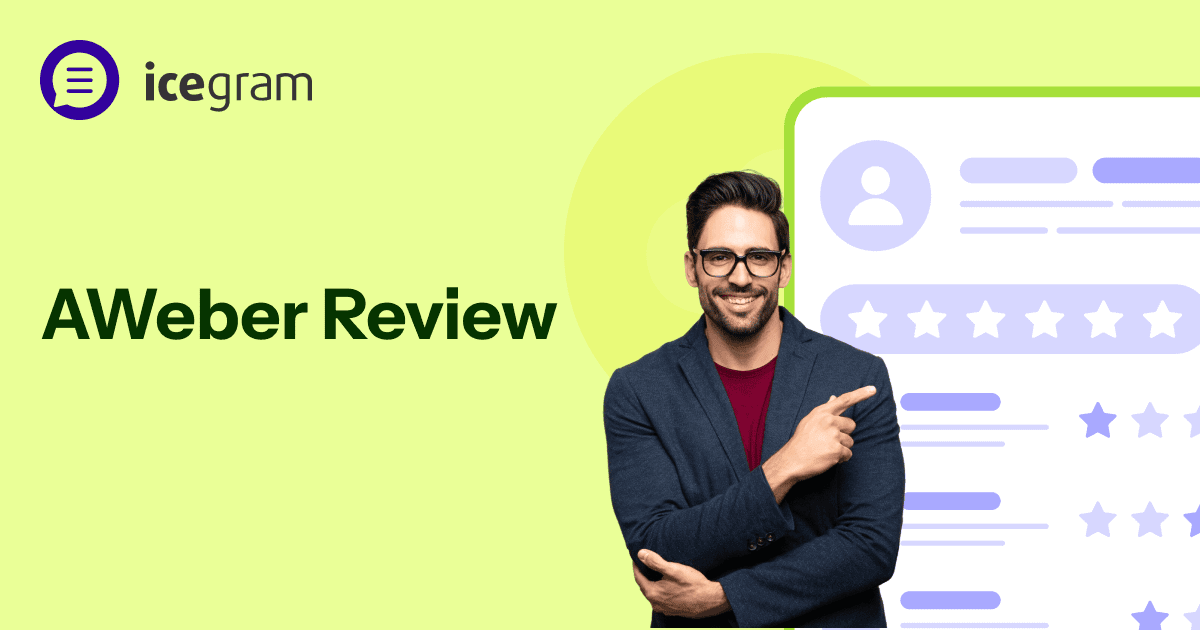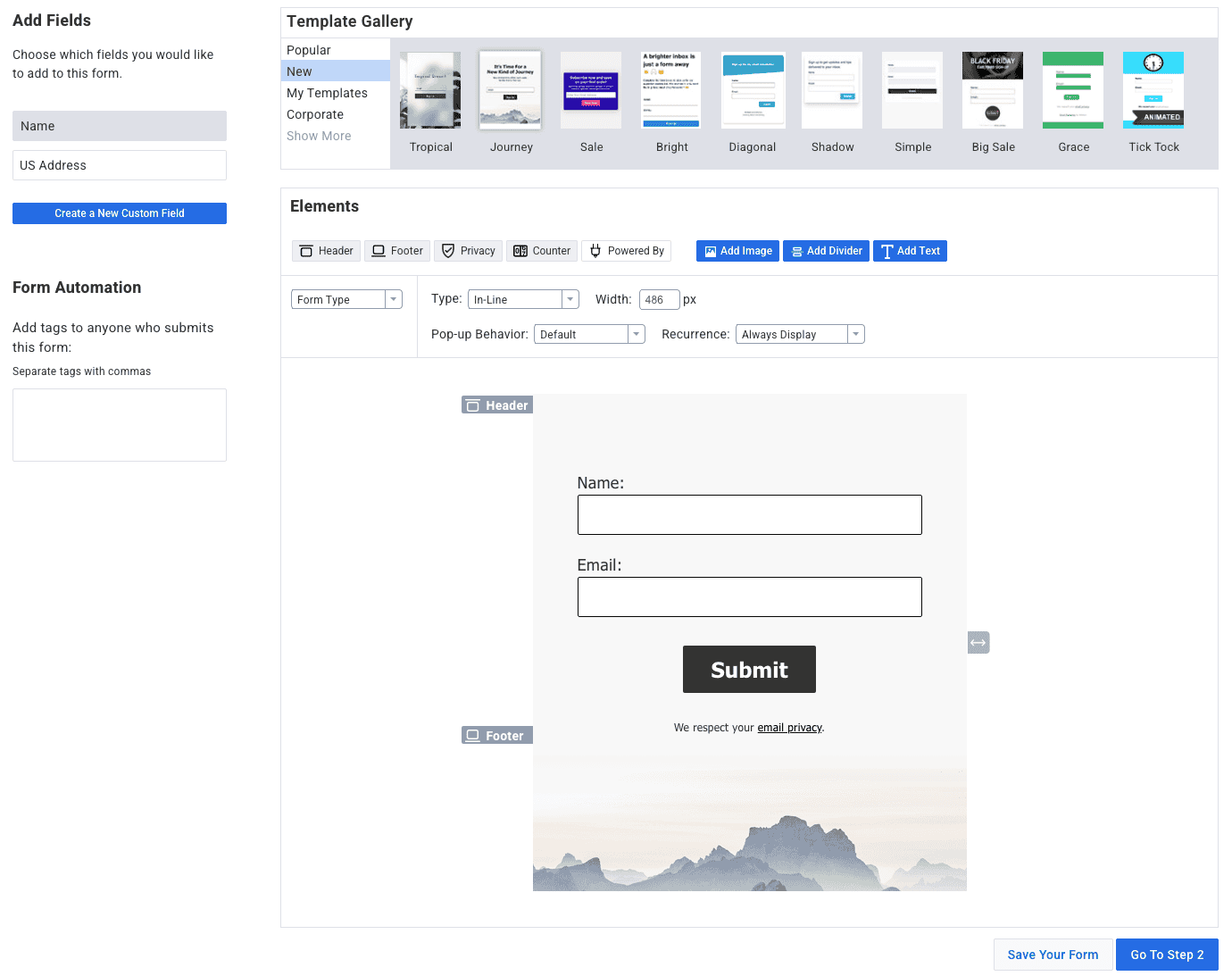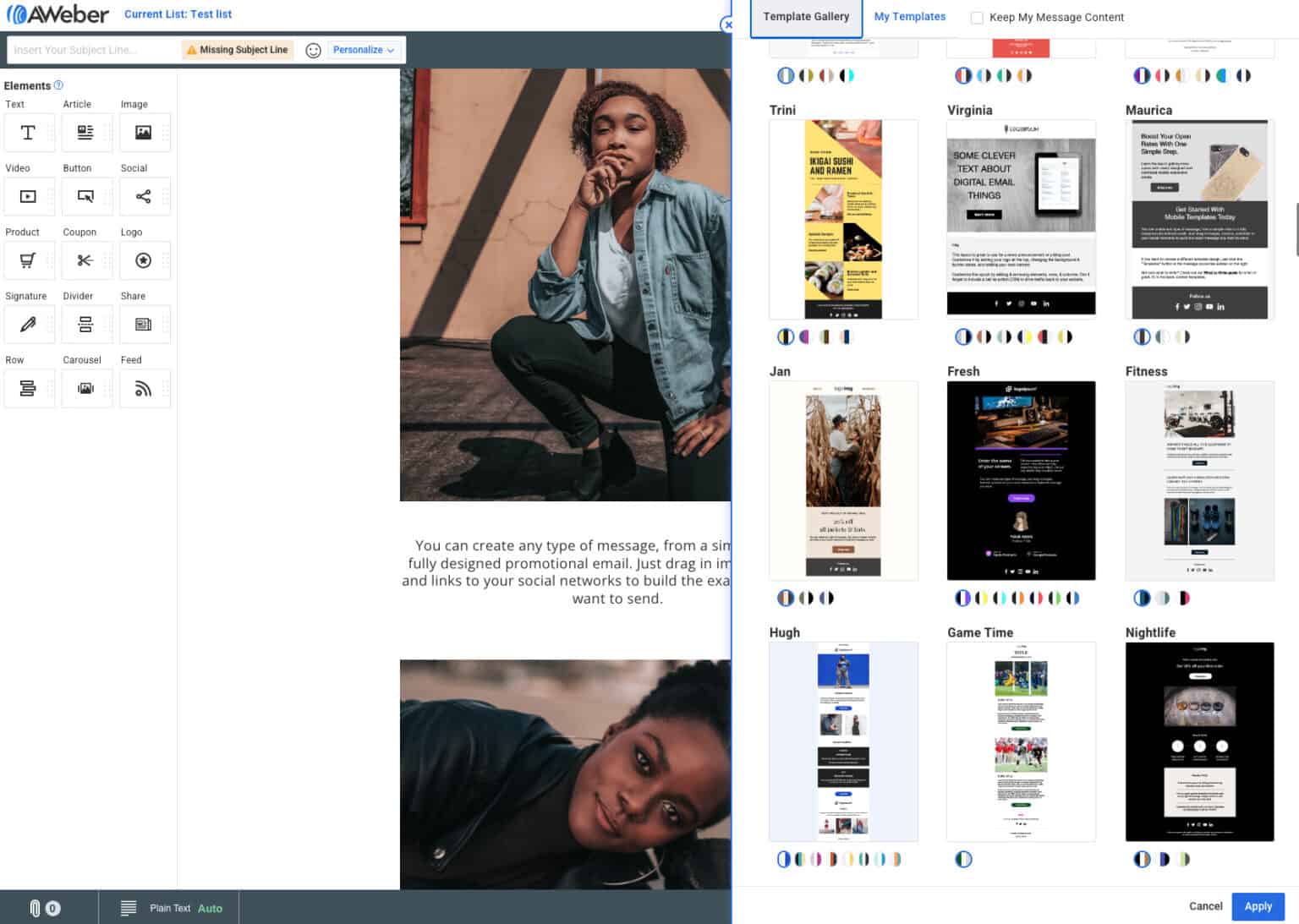With the current state of the SaaS market, being spoiled for choice is obvious.
But while you do have the choice, why not use the privilege to make the right decision?
However, making the right decision also comes with the need to invest time, effort and resources to find what works for you, often leading to a chain of trial and error.
Wish to avoid the unnecessary back and forth that can harm your business?
In this review, check out how AWeber fares in various categories and if it can work for your business.
What does AWeber do?
AWeber is an email marketing tool that helps businesses send newsletters, automate emails, grow subscriber lists, and track campaign performance.
Core features: Rated, reviewed, & explained
Simple interface
I cannot emphasize the importance of an excellent first impression.
And with email marketing tools, a clean interface does just the same.
An easy interface turns out to be a breath of fresh air for solopreneurs, small businesses, and creators who wish to start email marketing without wrestling with a complex UI. Features such as segmentation and automation are also easy to use without having to watch hours of tutorials.
While the simplicity is a pro for a lot of users, it may seem lacklustre for those looking for advanced features. Especially compared to tools that offer comprehensive features under one roof.
For example, if you’re a marketer looking to build sophisticated sales funnels, behavior-based automations, or manage multiple brands under one roof, this is where things might start feeling restricted.
In a nutshell, the platform focuses on simplicity over depth, which can be both a strength and a limitation.
Here’s what the dashboard looks like:
(Source: AWeber)
Creating an email
Creating an email or a newsletter is what I believe is the most important reason why users might sway towards AWeber.
To create an email, I highly suggest using the drag-and-drop editor, which is pretty easy to use. Moreover, anything that needs to be added somewhere gets done seamlessly.
You can add texts (of course!), images, emojis, buttons, dividers, videos, and other elements. You can also make your text bold, italic, underscore, and strikethrough. Videos can be added simply by adding the URL or through the drag-and-drop feature.
You can link specific text, change alignment, and add different bulleted or numbered lists.
To preview your message, you can go ahead and click on preview (allows you to preview your email on desktop and mobile devices) and test, making it easy to see how your email would look in your audience’s inbox.
Further, you can schedule your emails, leading to more options such as choosing dates and the lists you want to send them to.
If you have another list, you can edit and choose the segment that you wish to.
Likewise, you can also remove certain lists by adding certain automation aspects.
Automation
Automation helps send the email to your audience at the right time and exactly when they need to see it.
Along with automation, you can also take the manual route by adding tags yourself. For eg, after an individual has been welcomed, you remove that tag and add them to a different segment. You can also take them off the list and move them to a different one.
However, with all the efficient email marketing automation, what’s worth noting is that there’s no true visual automation builder, but rather just a basic campaign flow editor. It works, but doesn’t offer the visual clarity or branching logic that platforms like ConvertKit or ActiveCampaign make standard.
Filter
AWeber’s filters help you filter subscribers by engagement. So, whether they’re dormant subscribers, unengaged new subscribers, low engagement, moderate engagement, and high engagement, which can be very useful.
Besides that, you can also filter subscribers based on tags, signup source, engagement (like who opened or clicked), or whether they’re part of a specific list. If you’re managing a small to mid-sized list and want to quickly group users for a broadcast or a follow-up campaign, it gets the job done without too much fuss.
Here is what the broadcast setting looks like:

(Source: AWeber)
However, when you start looking for deeper segmentation logic, such as combining multiple conditions, you’ll quickly notice the limitations. It’s not as flexible or granular as some of the more advanced platforms like ActiveCampaign or MailerLite, which let you build hyper-targeted segments easily.
That said, for the average user who wants to send emails to people who clicked a certain link or signed up via a specific form, AWeber’s filters do the job without needing a degree in logic building.
In short: AWeber’s filter functionality is reliable for basic segmentation, but power users might crave more depth and smoother execution.
Next, let’s take a look at landing pages and forms.
Landing pages & forms
AWeber’s landing page builder, which works great when capturing leads without the need to build a separate website. That means you don’t need to be a web design expert.
This ease and flexibility allow you to create complex workflows that add another layer of automation for your email marketing efforts.
For example, you can set up a welcome series for new subscribers, automate follow-up emails based on subscriber behavior, and even send personalized emails triggered by specific actions.
Despite all this, seasoned marketers might find the builder to be a bit outdated and less intuitive compared to other email marketing tools.
Automation
AWeber offers a significant degree of automation to its users that can offer more efficiency to your workflows and save you a lot of time.
You can set up automated workflows to nurture your leads and customers.
Automation also helps you test different email subject lines or any content to see which one performs better.
If you are a beginner and need to automate simple tasks like sending a welcome series, tagging subscribers based on link clicks, or creating basic time-delay sequences, AWeber’s Campaigns feature delivers what you need. You can set triggers based on list joins or tags, and then build a linear sequence of emails with conditions like “if a link is clicked, apply this tag” or “wait 3 days, then send email #2.” It’s intuitive, clean, and doesn’t require a learning curve.
Where it starts to feel a bit limited is when you try to build out more complex logic. There’s no true visual workflow builder that lets you drag and drop conditions, branches, and actions in a canvas-style layout.
That makes it harder to visualize multi-step automations or create funnels with multiple conditional paths.
That said, for creators, coaches, and small businesses who want “set-it-and-forget-it” sequences, AWeber’s automation is reliable and easy to implement. It won’t blow your mind—but it won’t break it either.
Templates
Another outstanding way that automation has been integrated into AWeber is through templates. With AWeber, users get different templates and you can start from scratch as well.
There are plenty of categories to choose from.
A standout feature is the Keep My Content checkbox in the drag-and-drop email builder. This ensures that switching templates won’t overwrite your existing content. This allows you to add images, videos, texts, or URLs beforehand, which saves time every time you send an email.
Here’s how you can edit the AWeber template:
(Source: AWeber)
Here are some template categories that AWeber offers:
- Bio
- Blog or podcast
- Consultations
- E-commerce
- Events
- Webinar
- Freebies
- Lead magnet offer
- Opt-ins
This is what a range of AWeber templates looks like:
However, I feel it would be great if there were more opt-in page templates overall. This is so because these categories are the ones that get the audience to willingly sign up to the brand.
Integrations
Out of the box, AWeber integrates with hundreds of third-party tools across eCommerce, CRM, lead capture, webinar platforms, and more. AWeber integrates with platforms such as Shopify, WordPress, and Zapier, to name a few.
These integrations allow you to connect your email marketing with other parts of your business, helping you create a cohesive marketing strategy.
The UI for managing integrations is straightforward, though not as visual or centralized as some modern platforms. You’ll typically activate and manage each integration separately, which can feel disjointed if you’re juggling many tools.
Deliverability rates
During a thorough AWeber testing, the deliverability rates turned out to be surprisingly better for most major providers like Gmail, Outlook, and Yahoo. No unnecessary detours to the spam or promotions tab, which is a big win, especially if your emails are time-sensitive or conversion-driven.
AWeber claims a high deliverability rate, and while real-world results can vary based on your content, sender reputation, and list hygiene, my experience lines up pretty closely.
Transactional emails, welcome sequences, and broadcast newsletters all arrived as expected without major delays or bounce issues.
What really helps is that AWeber takes compliance regulations seriously. In a nutshell, it requires confirmed opt-ins (double opt-in by default, though you can switch to single), actively monitors accounts for spam complaints, and has strong relationships with ISPs. The automatic list cleaning also ensures hard bounces and inactive emails don’t keep dragging your sender reputation down.
In summary: AWeber may not have flashy AI deliverability tools, but what it offers is reliability and infrastructure that quietly do the heavy lifting, so your emails get where they’re supposed to go.
Autoresponders
AWeber’s autoresponders are one of those classic features that have stood the test of time, and that too for a good reason. Setting up automated email sequences is quick and beginner-friendly. Whether you’re welcoming new subscribers, delivering a freebie, or sending out a basic drip campaign, the process is clear and doesn’t feel overwhelming.
You create a campaign, choose your trigger (usually a signup form or tag), and then schedule the emails at custom intervals, day 1, day 3, day 7, and so on. As mentioned at the beginning of the article, the drag-and-drop interface helps you rearrange the emails mid-sequence.
Now, here’s where it’s a bit of a double-edged sword.
If you’re looking for simple, reliable automation, AWeber’s autoresponders do their job really well. But if you’re expecting more advanced behavior-based automations such as branching logic, multiple triggers, goal-based flows, or “if this, then that” scenarios, you’ll probably feel restricted.
It’s more of a linear sequence tool than a full-blown automation builder. Hence, for users who wish to communicate with their audience regularly, this might certainly come across as a hurdle.
Another thing to keep in mind is that AWeber doesn’t offer a visual workflow builder for autoresponders (unlike its Campaigns feature, which has more flow-based logic). This might be a limitation for marketers who want to build out conditional paths based on clicks, opens, or tags in a visual way.
Overall, AWeber’s autoresponders are dependable and easy to implement, especially for creators, bloggers, and small businesses who just want to set it and forget it. If your automation needs are straightforward, you’ll feel right at home.
But if you’re aiming for complex funnel logic, this might not be your final stop.
Pricing
In my opinion, AWeber’s pricing is not too bad. What makes it better is that users can try the tool for free and then opt to make a purchase.
You can get started for free for upto 500 subscribers, which allows you to send almost 3,000 emails per month with access to one email list, one landing image and one email automation. Additionally, the plan also includes basic email support.
Next comes the light plan, which costs $12.50 per month, billed annually.
And some of the features are that it’s ideal for those ready to upgrade their email game. You can send up to eight times your subscriber volume monthly with access to one email list, including three landing pages, three email automations and 24/7 support.
Next is the plus plan, which starts at $20 per month, billed annually, and is designed for creators looking to scale their business. You can send up to 12 times your subscriber volume monthly with unlimited lists, unlimited landing pages, and unlimited email automations.
Plus, you’ll get 24/7 customer support.
Lastly, there’s the unlimited plan at $899 per month when billed annually for those with extensive email needs.
However, in a nutshell, if your subscriber list grows, AWeber can get quite expensive. Whereas, the light plan might also seem limited to a few users, lacking features like the ability to remove the AWeber branding or advanced automation.
For users whose business requirements are extensive, AWeber offers custom plans tailored to subscribers of over 100,000 people.
Check out more about AWeber pricing here.
AWeber vs. Icegram Express
| Feature | AWeber | Icegram Express |
|---|---|---|
| Platform type | Standalone SaaS platform | Native WordPress plugin |
| Ease of Use | Clean interface, but may feel outdated | Intuitive and seamlessly integrates with the WordPress dashboard |
| Email Editor | Drag-and-drop editor with standard blocks | Simplified editor that works with WordPress theme styles |
| Forms and Lead Capture | Hosted and embeddable forms | Built-in popups, slide-ins, and inline forms with advanced targeting |
| Automation | Basic automation, tag-based flows | Visual automation builder with conditionals and multi-step sequences |
| Autoresponders | Time-delay and trigger-based | Automated sequences based on user activity, tags, or events |
| Segmentation | Basic tag and list-based segmentation | Advanced segmentation based on activity, custom fields, and engagement |
| Email Templates | 600+ pre-designed templates | Basic, clean templates optimized for deliverability and customization |
| Landing Pages | Included but limited customization | No built-in builder; integrates smoothly with Elementor, Gutenberg, etc. |
| Subscriber Limits (Free plans) | 500 subscribers with limited features | Unlimited subscribers |
| Email Sending Limits (Free plan) | 3,000 emails/month | 10,000 emails/month on the free plan |
| Deliverability | Reliable; uses AWeber’s own SMTP | High deliverability, supports any SMTP, including SendGrid, Amazon SES, etc. |
| Analytics and Reporting | Core reporting on opens, clicks, and unsubscribes | Detailed open, click, bounce, and device tracking |
| Integrations | Works with 100+ tools via API and third-party services | Natively integrates with major WordPress plugins (WooCommerce, LMS, etc.) |
| GDPR Tools | Built-in GDPR tools and double opt-ins | GDPR-ready with customizable consent options and compliance-friendly forms |
| Support | Email, chat, and phone support for paid plans | Email support + detailed knowledge base, even in the free plan |
| Pricing | Tiered pricing based on subscriber count | Flat affordable pricing based on features, not subscriber count |
| Best for | Traditional email marketers, small businesses | WordPress users, bloggers, creators, and growing online businesses |
Is Icegram Express the best alternative to AWeber?
If you’re on WordPress and want full control, better pricing, and deeper integration, Icegram Express is a standout alternative to AWeber. It offers unlimited subscribers, powerful automation, and native WordPress support, without the complexity or cost of a separate platform. For creators and small businesses, it’s a smarter, simpler choice.
Conclusion
I am sure a run-down like this is what you needed to make the right decision.
Overall, AWeber shines as a reliable and user-friendly email marketing tool, especially for users who are looking for simplicity and ease of use. Overall, it provides a comprehensive set of features that caters to the needs of both beginners and advanced users.
If your needs align with AWeber, it is a dependable tool worth considering.
What next?
Let us know if you wish to take the plunge and make AWeber a part of the team.
And if you have any suggestions, opinions, or alternatives that you wish to share with us, I am all ears!
See you in the comments below!
P.S.: Since you are on the lookout, allow us to tell you about a lightweight tool that offers a goldmine of features. Check out how Icegram Express can help!
FAQ
Can I use AWeber if I don’t have a website?
Yes, AWeber provides hosted landing pages and sign-up forms that let you collect subscribers without needing your own website. It’s a useful feature for creators, event marketers, or those building their audience before launching a site.
Does AWeber support SMS or push notifications?
Currently, AWeber does not offer built-in SMS or push notification tools. It is primarily focused on email marketing, though you may be able to integrate SMS functionality using third-party tools via Zapier or custom APIs.
Can I sell digital products directly through AWeber?
AWeber offers a built-in ecommerce feature that lets you sell digital products or services directly through their platform. It supports simple checkout pages and email delivery of products, making it handy for creators selling ebooks, courses, or services
Is there an affiliate program for AWeber?
Yes, AWeber runs an affiliate program where you can earn recurring commissions by referring new customers. It’s open to users and non-users alike and offers tracking tools through the AWeber Advocate dashboard.
How customizable are AWeber’s confirmation emails?
You can customize the confirmation emails (double opt-in) with your branding, language, and messaging, although the structure is still somewhat templated. It’s functional but not as flexible as platforms with fully customizable onboarding sequences.
Can I use AWeber for webinar signups and follow-ups?
Absolutely. You can integrate AWeber with webinar platforms like Zoom, GoToWebinar, or WebinarJam through Zapier. Once integrated, you can set up automated email sequences to send reminders, confirmations, and post-event follow-ups.




